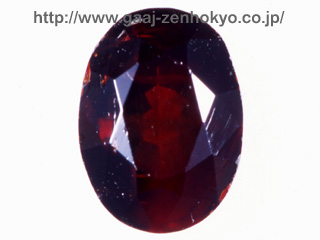|
||||||||||||
|
We recently tested rare gemstones of natural zincite. Their features are introduced here.
incite is an oxide of zinc (Zn) and it has a chemical formula of ZnO. A compound of this composition has been produced as gzinc whiteh for industrial use, and it has been widely used as additive for gum, cosmetics, coating compound or pharmaceutical compound. Also its nature as a semi-conductor draws attention these days and it has been playing an important role in the industrial field. In the middle of 1980s, single crystals of synthetic zincite, which had assumedly grown as a by-product during its synthesis for industrial use, started to appear on the gem market after being cut for jewellery use. The transparent and beautiful orange or green-yellow colour of the stone caught peoplefs eye and this synthetic zincite was circulated more often in the gem shows at many places. Our magazine gGemmologyh also featured this material in the issue of December 1995. In recent, its formation mechanism in zinc white production process was explained in an article in gthe Journal of Gemmologyh (vol. 30, pp 257-267). Thus, it is one of the materials that attract a lot of attention. Natural zincite, on the other hand, is famous for those from Franklin in New Jersey, USA, and it usually occurs as massive or granular but rarely in gem-quality. Its low hardness, 4 to 4.5, keeps it as a gem for collectors, and to general jewellers synthetic zincite is more recognised than the natural one therefore they hardly have information on natural zincite. We recently had an opportunity to test faceted natural zincite, and their gemmological features are introduced below. @@@The stones we tested this time were two pieces of 1.62 carat oval cut stone and 0.21 carat deformed cut stone. The former showed very deep red colour (photo 1), while the latter showed relatively brighter colour (photo 2). Their SG weighed 5.69 (by hydrostatic weighing method) and their RI values were over-scale on the standard gemmological refractometer. (According to a document, its RI is 2.013-2.029.)
They were inert under LWUV, but showed dark red colour under SWUV. Some report says that synthetic stones, although depending on the body colour, show mainly yellow to orange fluorescence and it tends to be stronger in LWUV than in SWUV. These features are different from those of the natural ones that were tested this time. @@@In magnification test, fluid, liquid film negative crystals, growth-tube and cloud inclusions that were distributed throughout the stones were observed (photo 3). Contrary to this, synthetic stones reportedly have very high transparency and hardly have any inclusion, or may only be with minute inclusions or dislocations. Chemical composition analysis with X-ray fluorescence revealed that, as well as the main composition component Zn, manganese (Mn) that are supposedly a cause of colour were contained in the faceted deep red stone in the amount of about 1.75 wt% as MnO, and in the brighter red stone about 0.36 wt%. ng materials.
For further information, please contact: GAAJ-ZENHOKYO Laboratory E-mail: j-kawano@gaaj-zenhokyo.co.jp Website: http://www.gaaj-zenhokyo.co.jp/index-e.html |


